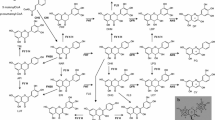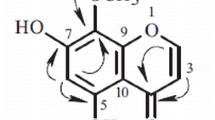Abstract
Flavonoid analysis and supplementation experiments with dihydroflavonols and leucocyanidin on two cyanic, two acyanic and one white/red-variegated flowering strain of Dianthus caryophyllus (carnation) showed that in the acyanic strains recessive alleles (aa) of the gene A interrupt the anthocyanin pathway between dihydroflavonols and leucoanthocyanidins. The instability in the variegated strain involves the same step and is obviously caused by the multiple allele a var. In confirmation of these results, dihydroflavonol 4-reductase activity could be demonstrated in enzyme extracts from cyanic flowers and cyanic parts of variegated flowers but not in preparations from acyanic flowers or acyanic parts. The enzyme catalyzes the stereospecific reduction of (+)dihydrokaempferol to (+)-3,4-leucopelargonidin with NADPH as cofactor. A pH optimum around 7.0 and a temperature optimum at 30° C was determined, but the reduction reaction also proceeded at low temperatures. (+)Dihydroquercetin and (+)dihydromyricetin were also reduced to the respective flavan-3,4-cis-diols by the enzyme preparations from carnation flowers, and were even better substrates than dihydrokaempferol.
Similar content being viewed by others
References
Barton, G.M. (1968) Detection of 3-hydroxyflavanones on papergrams and thin-layer plates. J. Chromatogr. 34, 562
Fischer, D., Stich, K., Britsch, K., Grisebach, H. (1988) Purification and characterization of (+)dihydroflavonol (3-hydroxyflavanone) 4-reductase from flowers of Dahlia variabilis. Arch. Biochem. Biophys. 264, 40
Forkmann, G., Dangelmayr, B. (1980) Genetic control of chalcone isomerase activity in flowers of Dianthus caryophyllus. Biochem. Genet. 18, 519
Forkmann, G., Ruhnau, B. (1987) Distinct substrate specificity of dihydroflavonol 4-reductase from flowers of Petunia hybrida. Z. Naturforsch. 42c, 1146
Geissman, T.A., Mehlquist, G.A.L. (1947) Inheritance in the carnation, Dianthus caryophyllus. IV. The chemistry of flower color variation, I. Genetics 32, 410
Geissman, T.A., Hinreiner, E.H., Jorgensen, E.C. (1956) Inheritance in the carnation, Dianthus caryophyllus. V. The chemistry of flower color variation. II. Genetics 41, 93
Harborne, J.B. (1966) Comparative biochemistry of flavonoids. I. Distribution of chalcone and aurone pigments in plants. Phytochemistry 5, 111
Harborne, J.B. (1967) Comparative biochemistry of flavonoids. Academic Press, New York
Heller, W. Forkmann G. (1988) Biosynthesis. In: The flavonoids, Harborne, J.B., ed. Chapman and Hall, London
Heller, W., Britsch, L., Forkmann, G. Grisebach, H. (1985a) Leucoanthocyanidins as intermediates in anthocyanidin biosynthesis in flowers of Matthiola incana R. Br. Planta 163, 191
Heller, W., Forkmann, G., Britsch, L., Grisebach, H. (1985b) Enzymatic reduction of (+)dihydroflavonols to flavan-3,4-cisdiols with flower extracts from Matthiola incana and its role in anthocyanin biosynthesis. Planta 165, 284
Ishikura, N., Murakami, H., Fujii, Y. (1988) Conversion of (+)dihydroquercetin to 3,4-cis-leucocyanidin by a reductase extracted from cell suspension cultures of Cryptomeria japonica. Plant Cell Physiol. 29, 795
Kristiansen, K.N. (1986) Conversion of (+)-dihydroquercetin to (+)-2,3-trans-3,4-cis-leucocyanidin and +)-catechin with an enzyme extract from maturing grains of barley. Carlsberg Res. Commun. 51, 51
Mehlquist, G.A.L., Geissman, T.A. (1947) Inheritance in the carnation (Dianthus caryophyllus) III. Inheritance of flower color. Ann. Missouri Bot. Gard. 34, 39
Reddy, A.R., Britsch, L., Salamini, F., Saedler, H., Rohde, W. (1987) The A1 (Anthocyanin-1) locus in Zea mays encodes dihydroquercetin reductase. Plant Sci. 52, 7
Ruhnau, B., Forkmann, G. (1988) Flavan-3,4-diols in anthocyanin biosynthesis, enzymatic formation with flower extracts from Callistephus chinensis. Phytochemistry 27, 1039
Sagawa, Y., Mehlquist, A.L. (1957) The mechanism responsible for some x-ray induced changes in flower color of the carnation, Dianthus caryophyllus. Am J. Bot. 44, 397
Sandermann, H., Strominger, L. (1972) Purification and properties of C55-isoprenoid alcohol phosphokinase from Staphylococcus aureus. J. Biol. Chem. 247, 5123
Spörlein, B. (1986) Enzymatische Untersuchung zur Anthocyanbiosynthese in Keimlingen genetisch definierter Linien der To mate (Lycopersicon esculentum). Diploma Thesis, Inst. Biol. II, Univ. Tübingen, Germany
Spribille, R., Forkmann, G. (1982) Chalcone synthesis and hydroxylation of flavonoids in 3′-position with enzyme preparations from flowers of Dianthus caryophyllus L. (carnation). Planta 155, 176
Stafford, H.A., Lester, H.H. (1984) Flavan-3-ol biosynthesis. The conversion of (+)-dihydroquercetin and flavan-3,4-cis-diol (leucocyanidin) to (+)-catechin by reductases extracted from cell suspension cultures of douglas fir. Plant Physiol. 76, 184
Stafford, H.A., Lester, H.H. (1985) Flavan-3-ol Biosynthesis. The conversion of (+)-dihydromyricetin to its flavan-3,4-diol (leucodelphinidin) and to (+)-gallocatechin by reductases extracted from tissue cultres of Ginkgo biloba and Pseudotsuga menziessii. Plant Physiol. 78, 791
Stafford, H.A., Lester, H.H., Porter, L.J. (1985) Chemical and enzymatic synthesis of monomeric procyanidins (leucocyanidins or 3′,4′,5,7-tetrahydroxyflavan-3,4-diols) from (2R, 3R)dihydroquercetin. Phytochemistry 24, 333
Stich, K., Forkmann, G. (1988a) Biosynthesis of 3-deoxyanthocyanins with flower extracts from Sinningia cardinalis. Phytochemistry 27, 785
Stich, K., Forkmann, G. (1988b) Studies on columnidin biosynthesis with flower extracts from Columnea hybrida. Z. Naturforsch. 43c, 311
Teusch, M. (1986) Uridine 5′-diphosphate-xylose: anthocyanidin 3-O-glucose-xylosyl-transferase from petals of Matthiola incana R. Br. Planta 169, 559
Teusch, M., Forkmann, G., Seyffert, W. (1986) Genetic control of UDP-glucose: anthocyanin 5-O-glucosyl-transferase from flowers of Matthiola incana R. Br. Planta 168, 586
Teusch, M., Forkmann, G., Seyffert, W. (1987) Genetic control of hydroxycinnamoyl-coenzyme A: anthocyanidin 3-glycosidehydroxycinnamoyltransferase from petals of Matthiola incana. Phytochemistry 26, 991
Author information
Authors and Affiliations
Additional information
These investigations were supported by grants from Fonds zur Förderung der wissenschaftlichen Forschung and Deutsche Forschungsgemeinschaft. The authors thank the market-gardens Ing. K. Rungaldier (Vienna, Austria), A. Sinner (Tübingen, FRG) and Barbaret & Blanc GMBH (Horhausen, FRG) for generous support with plant material.
Rights and permissions
About this article
Cite this article
Stich, K., Eidenberger, T., Wurst, F. et al. Enzymatic conversion of dihydroflavonols to flavan-3,4-diols using flower extracts of Dianthus caryophyllus L. (carnation). Planta 187, 103–108 (1992). https://doi.org/10.1007/BF00201630
Accepted:
Issue Date:
DOI: https://doi.org/10.1007/BF00201630




